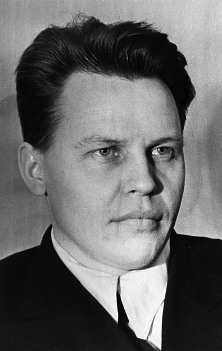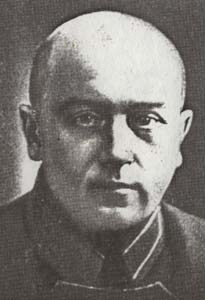Related Research Articles
The 500 Days Program was a shock therapy program to overcome the economic crisis in the Soviet Union by means of a transition to a market economy. Intended to comprehensively change the Soviet Union in a span of two years, it was ultimately a factor leading to the Soviet Union's collapse.

Nikolai Alekseevich Voznesensky was a Soviet politician and economic planner who oversaw the running of Gosplan during the German–Soviet War of 1941–1945. A protégé of Andrei Zhdanov, Voznesensky was appointed Deputy Premier in May 1940. He became directly involved in the recovery of production associated with the evacuation of industry eastwards after the start of the war. His 1947 work The Economy of the USSR during World War II records those years.

Aron Iosifovich Katsenelinboigen was a founder of predispositioning theory, a subject in decision theory and systems theory that models development in the context of uncertainty.

Lev Markovich Gatovsky was a Soviet economist, being one of the first who tried to create a theoretical framework in which to understand the nature of the socialist project taking place in the Soviet Union from a political economy perspective. He became director of the Institute of Economics of the Soviet Academy of Sciences, later renamed Russian Academy of Sciencies, from 1965 to 1971. Apart from his general academic work, he contributed to several major economic developments such as the first two five-year economic plans and the 1965 Soviet Economic Reform, as well as editing the first Political Economy textbook of the USSR.

Gleb Maksimilianovich Krzhizhanovsky was a Soviet scientist, statesman, revolutionary, Old Bolshevik, and state figure as well as a geographer and writer.

Maksim Zakharovich Saburov was a Soviet engineer, economist and politician, three-time Chairman of Gosplan and later First Deputy Premier of the Soviet Union. He was involved in the Anti-Party Group's attempt to displace Nikita Khrushchev in 1957.
Stanislav Ivanovich Stepashkin was an Olympic boxer from the Soviet Union.
Maria Natanovna Smith-Falkner was a Soviet economist, statistician and a corresponding member of the Academy of Sciences of the USSR from 1939 onwards. She was a member of the Communist Party of the Soviet Union, having joined the Bolsheviks in 1918.

The State University of Management is a public university in Moscow, Russia. It was founded in 1919. Its rector is Ivan Vasilyevich Lobanov. There are more than 250 professors and 12 academics and members of the Russian Academy of Sciences working at the university.

Nikolai Vladimirovich Talyzin was a Soviet statesman, economist and head of the Gosplan, or the State Planning Committee.
Stanislav Mikhaĭlovich Menʹshikov, was a Russian economist and former Soviet diplomat. He is the author of numerous publications in Russian and English including The Anatomy of Russian Capitalism, and a chapter in Capitalism, Communism and Coexistence. He was a professor at the Central Economic Mathematical Institute at the Russian Academy of Sciences in Moscow. Menshikov was married to fellow economist Larissa Klimenko-Menshikova.
The DerzhPlan of the Ukrainian SSR or State Planning Committee of the Ukrainian SSR was a union-republican authority that conducted state planning of economical and social development of the Ukrainian SSR and controlled execution of national economical plans.

Valery Ivanovich Mezhlauk (1893–1938) was a government and party official in the Soviet Union during the decades of the 1920s and 1930s. He is best remembered as the Chairman of the State Planning Committee (Gosplan) from 1934 to 1937. He became a victim of Stalin’s Great Purge and was executed on July 29, 1938. He was posthumously rehabilitated in 1956.

The State Planning Committee, commonly known as Gosplan , was the agency responsible for central economic planning in the Soviet Union. Established in 1921 and remaining in existence until the dissolution of the Soviet Union in 1991, Gosplan had as its main task the creation and administration of a series of five-year plans governing the economy of the USSR.
Vladimir Gustavovich Groman was a Menshevik economist and statistician active in Gosplan, the Soviet Union's central economic planning agency and the Central Statistical Directorate.
Soviet-type economic planning (STP) is the specific model of centralized planning employed by Marxist–Leninist socialist states modeled on the economy of the Soviet Union (USSR).
Saul Grigorievich Bron, was a Soviet trade representative in United States and Great Britain. He is best known as Chairman of Amtorg Trading Corporation in New York City (1927–1930) and Chairman of the All-Russian Co-operative Society (ARCOS) in London (1930–1931). He became a victim of Stalin's Great Purge and was executed on 21 April 1938. He was posthumously rehabilitated in 1956.

Stanislav Adamovich Messing was a Soviet national party leader and a leader of the Soviet state security and intelligence bodies. He was a member of the Central Control Commission of the CPSU(b) from 1930 to 1934.

Lev Natanovich Kritzman was a Soviet Marxian economist who became a prominent advocate of state planning in the 1920s Soviet economy. After 1929, his views on agricultural reform were aligned with mass collectivisation and dekulakization introduced by Joseph Stalin.

Stanislav Sergeyevich Shatalin was a Soviet and Russian economist. A corresponding member of the Academy of Sciences of the Soviet Union from 1974 and an academic from 1987, Shatalin played an important role in economic reforms shortly before and following the dissolution of the Soviet Union, when he promoted the policies of decentralisation and privatisation in an effort to improve productivity. Although he was the primary author of the ambitious 500 Days Programme and an early supporter of Russian economic reforms, he was soon sidelined by younger, more radical economists who sought even further reforms than Shatalin.
References
- ↑ Remington, Thomas F. (1984). Building socialism in Bolshevik Russia: ideology and industrial organization 1917-1921. Pittsburgh, Pa: University of Pittsburgh press. ISBN 0-8229-3809-X.
- ↑ "Струмилин Станислав Густавович". warheroes.ru. Retrieved 2021-10-02.
- ↑ Strumilin, S. G. (1962). "The economics of education in the USSR" (PDF). International Social Science Journal. XIV (4): 633–646. Retrieved 8 December 2014.